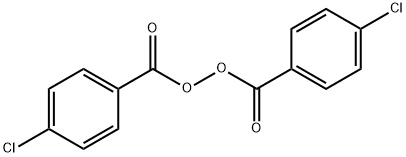p-Chlorobenzoyl peroxide Bis(p-ehlorobenzoyl)peroxide
- CAS NO.:94-17-7
- Empirical Formula: C14H8Cl2O4
- Molecular Weight: 311.12
- MDL number: MFCD00072660
- EINECS: 202-310-3
- SAFETY DATA SHEET (SDS)
- Update Date: 2024-12-18 14:15:32

What is p-Chlorobenzoyl peroxide Bis(p-ehlorobenzoyl)peroxide?
Chemical properties
White, odorless powder. Decomposes violently on heating or contamination. Insoluble in water; soluble in organic solvents.
The Uses of p-Chlorobenzoyl peroxide Bis(p-ehlorobenzoyl)peroxide
Curing agent for silicone rubbers.
Definition
A mixture of 50% bis(p-chlorobenzoyl)peroxide in silicone fluid.
General Description
Odorless white solid or paste. Sinks in water.
Reactivity Profile
In pure crystalline form there is danger of explosion upon heating, shock, or friction. Peroxides are good oxidizing agents. Organic compounds can ignite on contact with concentrated peroxides. Strongly reduced material such as sulfides, nitrides, and hydrides may react explosively with peroxides. There are few chemical classes that do not at least produce heat when mixed with peroxides. Many produce explosions or generate gases (toxic and nontoxic). Generally, dilute solutions of peroxides (<70%) are safe, but the presence of a catalyst (often a transition metal such as cobalt, iron, manganese, nickel, or vanadium) as an impurity may even then cause rapid decomposition, a buildup of heat, and even an explosion.
Hazard
Dangerous fire and explosion risk, explodes when heated to 38C, strong oxidizer, will ignite on contact with organic materials. Store in dark, cool locality. Toxic.
Health Hazard
Irritates eyes and (on prolonged contact) skin. Ingestion causes irritation of mouth and stomach.
Safety Profile
Moderately toxic byintraperitoneal route. Probably an irritant to skin andmucous membranes. Dangerous fire hazard; a powerfuloxidizer. Store in a cool place away from fire hazards,sparks, open flames, and out of the direct rays of the sun.Dangerous e
Carcinogenicity
The only other data available for this organic peroxide show that it had no effects on tumor cells when injected intraperitoneally at 125mg/kg in the chest wall of mice .
Properties of p-Chlorobenzoyl peroxide Bis(p-ehlorobenzoyl)peroxide
| Melting point: | 137-138 °C |
| Boiling point: | 427.4±55.0 °C(Predicted) |
| Density | 1.4614 (estimate) |
| color | A white, granular material |
| EPA Substance Registry System | Peroxide, bis(4-chlorobenzoyl) (94-17-7) |
Safety information for p-Chlorobenzoyl peroxide Bis(p-ehlorobenzoyl)peroxide
Computed Descriptors for p-Chlorobenzoyl peroxide Bis(p-ehlorobenzoyl)peroxide
p-Chlorobenzoyl peroxide Bis(p-ehlorobenzoyl)peroxide manufacturer
Stereokem Pvt Ltd
New Products
Tert-butyl bis(2-chloroethyl)carbamate 4-Methylphenylacetic acid N-Boc-D-alaninol N-BOC-D/L-ALANINOL N-octanoyl benzotriazole 3-Morpholino-1-(4-nitrophenyl)-5,6-dihydropyridin- 2(1H)-one Furan-2,5-Dicarboxylic Acid DIETHYL AMINOMALONATE HYDROCHLORIDE 1,1’-CARBONYLDIIMIDAZOLE R-2-BENZYLOXY PROPIONIC ACID 1,1’-CARBONYLDI (1,2-4 TRIAZOLE) N-METHYL INDAZOLE-3-CARBOXYLIC ACID (2-Hydroxyphenyl)acetonitrile 4-Bromopyrazole 5-BROMO-2CYANO PYRIDINE 5,6-Dimethoxyindanone 5-broMo-2-chloro-N-cyclopentylpyriMidin-4-aMine 2-(Cyanocyclohexyl)acetic acid 4-methoxy-3,5-dinitropyridine 1-(4-(aminomethyl)benzyl)urea hydrochloride 2-aminopropyl benzoate hydrochloride diethyl 2-(2-((tertbutoxycarbonyl)amino) ethyl)malonate tert-butyl 4- (ureidomethyl)benzylcarbamate Ethyl-2-chloro((4-methoxyphenyl)hydrazono)acetateYou may like
-
 Bis-(4-chlorobenzoyl)-peroxide 98%View Details
Bis-(4-chlorobenzoyl)-peroxide 98%View Details -
 1975-50-4 98%View Details
1975-50-4 98%View Details
1975-50-4 -
 2-HYDROXY BENZYL ALCOHOL 98%View Details
2-HYDROXY BENZYL ALCOHOL 98%View Details
90-01-7 -
 2-Chloro-1,3-Bis(Dimethylamino)Trimethinium Hexafluorophosphate 221615-75-4 98%View Details
2-Chloro-1,3-Bis(Dimethylamino)Trimethinium Hexafluorophosphate 221615-75-4 98%View Details
221615-75-4 -
 61397-56-6 CIS BROMO BENZOATE 98%View Details
61397-56-6 CIS BROMO BENZOATE 98%View Details
61397-56-6 -
 14714-50-2 (2-Hydroxyphenyl)acetonitrile 98+View Details
14714-50-2 (2-Hydroxyphenyl)acetonitrile 98+View Details
14714-50-2 -
 118753-70-1 98+View Details
118753-70-1 98+View Details
118753-70-1 -
 733039-20-8 5-broMo-2-chloro-N-cyclopentylpyriMidin-4-aMine 98+View Details
733039-20-8 5-broMo-2-chloro-N-cyclopentylpyriMidin-4-aMine 98+View Details
733039-20-8